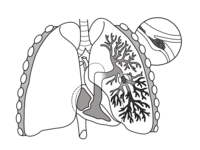
Photo from wikipedia
OBJECTIVES Coronavirus disease 2019 (COVID-19) can lead to systemic coagulation activation and thrombotic complications including venous thromboembolism. This study compares the development of pulmonary embolism, post-thrombotic syndrome, and clinical outcomes… Click to show full abstract
OBJECTIVES Coronavirus disease 2019 (COVID-19) can lead to systemic coagulation activation and thrombotic complications including venous thromboembolism. This study compares the development of pulmonary embolism, post-thrombotic syndrome, and clinical outcomes of COVID-19 and non-COVID-19 patients with deep vein thrombosis (DVT). METHODS One hundred and eight patients diagnosed with acute deep vein thrombosis (DVT) between June 2020 and February 2021 in our institution were included in this retrospective study. Thirty-nine patients had been previously diagnosed with COVID-19 and specified as the COVID-19 group. Sixty-nine patients did not have COVID-19 and specified as the non-COVID-19 group. Mean ages of both groups were 64.3 ± 15.8 and 60.1 ± 19.7 years, respectively (p = .37). RESULTS The median duration from the onset of the COVID-19 to diagnosis of DVT was 22 (2-120) days in the COVID-19 group. The patients of two groups were mostly treated outpatient at rates of 94.9% vs 94.2%, respectively (p = .88). Pulmonary embolism was seen in six patients (15.4%) in the COVID-19 group and in three patients (4.3%) in the non-COVID-19 group (p = .04). Kaplan-Meir curves showed that patients with COVİD-19 had significantly higher pulmonary embolism than those without COVID-19 (p = .015). The recurrence rate of DVT was 2.6% in the COVID-19 group (n = 1), and 4.3% in the non-COVID-19 group (n = 3), indicating no statistically significant difference (p = .63). Mortality was seen in six patients (15.4%) in the COVİD-19 group, and in seven patients (10.1%) in the non-COVID-19 group. According to the Kaplan-Meir method, 10 months survival rates were 73.9 ± 10% in the COVID-19 group, and 66.3 ± 12.8% in the non-COVID-19 group with no statistical significance (p = .218). CONCLUSIONS Our data draw attention to the fact that deep vein thrombosis should not be considered a safe and self-limited condition. Efficient preventive measures such as mobilization and prophylactic drug use should be considered to prevent DVT during the management of COVID-19.
Journal Title: Vascular
Year Published: 2021
Link to full text (if available)
Share on Social Media: Sign Up to like & get
recommendations!